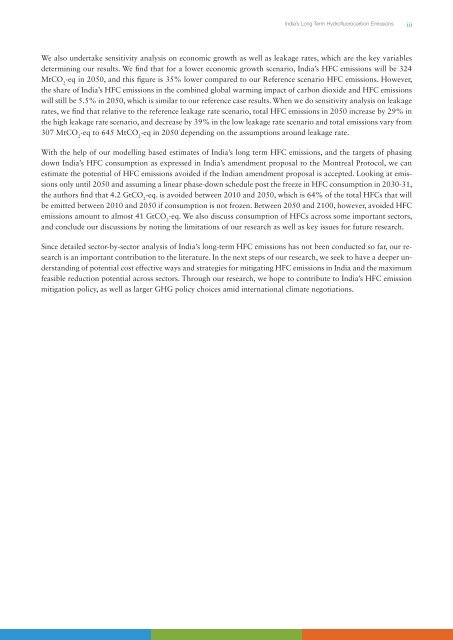Hydrofluorocarbon Emissions-Shakti Sustainable Energy Foundation
One such critically important category of gases is hydrofl uorocarbon (HFC). HFCs are potent greenhouse gases and are expected to contribute signifi cantly to global warming by 2050 (IPCC/TEAP, 2006; Velders et al., 2009; Gschrey et al., 2011; Miller & Kuijpers, 2011; Höglund-Isaksson et al., 2013). Read more information visit: http://shaktifoundation.in/report/indias-long-term-hydrofluorocarbon-hfc-emissions-detailed-cross-sectoral-analysis/
One such critically important category of gases is hydrofl uorocarbon (HFC). HFCs are potent greenhouse gases and are expected to contribute signifi cantly to global warming by 2050 (IPCC/TEAP, 2006; Velders et al., 2009; Gschrey et al., 2011; Miller & Kuijpers, 2011; Höglund-Isaksson et al., 2013). Read more information visit: http://shaktifoundation.in/report/indias-long-term-hydrofluorocarbon-hfc-emissions-detailed-cross-sectoral-analysis/
Create successful ePaper yourself
Turn your PDF publications into a flip-book with our unique Google optimized e-Paper software.
India’s Long Term Hydrofl uorocarbon <strong>Emissions</strong><br />
iii<br />
We also undertake sensitivity analysis on economic growth as well as leakage rates, which are the key variables<br />
determining our results. We find that for a lower economic growth scenario, India’s HFC emissions will be 324<br />
MtCO 2<br />
-eq in 2050, and this figure is 35% lower compared to our Reference scenario HFC emissions. However,<br />
the share of India’s HFC emissions in the combined global warming impact of carbon dioxide and HFC emissions<br />
will still be 5.5% in 2050, which is similar to our reference case results. When we do sensitivity analysis on leakage<br />
rates, we find that relative to the reference leakage rate scenario, total HFC emissions in 2050 increase by 29% in<br />
the high leakage rate scenario, and decrease by 39% in the low leakage rate scenario and total emissions vary from<br />
307 MtCO 2<br />
-eq to 645 MtCO 2<br />
-eq in 2050 depending on the assumptions around leakage rate.<br />
With the help of our modelling based estimates of India’s long term HFC emissions, and the targets of phasing<br />
down India’s HFC consumption as expressed in India’s amendment proposal to the Montreal Protocol, we can<br />
estimate the potential of HFC emissions avoided if the Indian amendment proposal is accepted. Looking at emissions<br />
only until 2050 and assuming a linear phase-down schedule post the freeze in HFC consumption in 2030-31,<br />
the authors find that 4.2 GtCO 2<br />
-eq. is avoided between 2010 and 2050, which is 64% of the total HFCs that will<br />
be emitted between 2010 and 2050 if consumption is not frozen. Between 2050 and 2100, however, avoided HFC<br />
emissions amount to almost 41 GtCO 2<br />
-eq. We also discuss consumption of HFCs across some important sectors,<br />
and conclude our discussions by noting the limitations of our research as well as key issues for future research.<br />
Since detailed sector-by-sector analysis of India’s long-term HFC emissions has not been conducted so far, our research<br />
is an important contribution to the literature. In the next steps of our research, we seek to have a deeper understanding<br />
of potential cost effective ways and strategies for mitigating HFC emissions in India and the maximum<br />
feasible reduction potential across sectors. Through our research, we hope to contribute to India’s HFC emission<br />
mitigation policy, as well as larger GHG policy choices amid international climate negotiations.

















